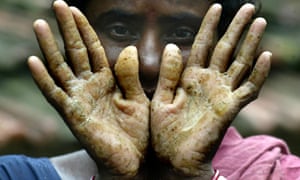http://e-info.org.tw/node/118162
喝一口淨水越來越難 聯合國:全球水污染達史上高峰
文字大小
374 2 Share1
本報2016年9月6日綜合外電報導,姜唯編譯;蔡麗伶審校
根據聯合國環境規劃署(UNEP)最新發表的報告指出,上億人暴露於感染霍亂和傷寒等水污染相關傳染病的風險中,其中亞洲、非洲和拉美的水污染情況正在惡化,超過半數的河水含有病原體。
「水污染疾病致死率已開始減少,現在的大問題是致病率。生病的人越來越多,我們的水資源污染空前嚴重。」密西根州立大學水研究室主任、微生物學家瓊安・蘿斯(Joan Rose)表示。
2000年5月,加拿大發生嚴重的水污染事件,沃可頓(Walkerton)小鎮因為牛糞掉到水井中,造成5,000個居民半數身染重病、七人死亡。政府隱瞞了真正的污染規模,人們只是打開水龍頭喝水卻賠上性命。而每年有上百件類似污染事件在世界各角落上演。
大部分水污染即肇因於污水污染飲用水,Rose指出,光是「美國一年有1200萬至1800萬件水污染致病病例。而在開發中國家的醫院中,可能每三人就有一人因水污染致病。我們不知道確切數字,但大約有15億人活在沒有妥善污水處理設備的地方。」而這個問題在氣候變遷之下更為嚴重。
「全球70億人口,大部分的排泄物進入水中。湖泊、河流和海岸的水質正在快速劣化。1950年代起,人口和牲畜、用水、農藥和化肥用量都大量增加,濕地則快速減少。」蘿斯說。
「我們正在改變著土地。土地是污染來源,但氣候是污染的驅動因素。降雨、風暴和乾旱的強度正在改變。美國每年超過50%的社區水污染疾病和暴雨有關。」
蘿斯指出,發生暴雨或洪水時,鉤端螺旋體、肝炎、諾羅病毒和隱孢子蟲等病原體都會增加。水污染、食物傳染疾病爆發和海洋暖化直接相關。溫度、降雨、溼度和洪水都是病原體污染水和糧食系統的因子。
而污水中有超過100種不同的病毒,甚至出現許多新興病毒,像是在亞洲造成兒童神經疾病的「環病毒」。這些病毒更有可能以不同傳播方式散佈到世界各地。
目前,Rose正在研究新病原體和病毒如何透過船隻的壓艙水散佈到全世界。她認為,穩定船隻重心的壓艙水會將病毒從一處海洋帶到另一處。
維護乾淨水資源代價不斐 但絕對值得投資
「我們正讓整個食物鏈系統受到感染。我們對於地球的生物健康到底缺少了哪些知識?我們如何知道野外發生了什麼事?青蛙正在死亡、海星正在死亡。我們的注意力都放在人身上,忽略其他動物。全世界各個角落都受到病毒和病原體的侵襲。」蘿斯說,要解決這些問題,必須大量投資水資源基礎設施,「不過光是在美國,就需要平均每人每天支付70美元,連續花十年。開發中國家更是昂貴。」
但蘿斯認為,這樣的投資一定值得,「乾淨的水資源是穩定社會的重要條件,缺少乾淨水資源造成社會動盪。身為微生物學家,我相信乾淨水資源是社會健康與成功的基礎。」
好消息是,科學家現在有更好的技術可以監控病原體和追蹤來源。「以前診斷要花三周,現在只要24小時。淨水獲得更多公眾支持,金援、政治資源也更多。人們知識更充足,也願意付出。」
蘿斯也表示,排除困難的關鍵在教育,尤其是全球水資源相關課程的發展,必須培育能解決問題的下一代。
Cleaning the world's water: 'We are now more polluted than we have ever been'
Joan Rose, a microbiologist who has won the world’s most prestigious water prize, is both depressed and optimistic at progress to make water fit to drink
In May 2000, around half of Walkerton’s 5,000 residents fell severely ill and seven people died when cow manure washed into a well. The extent of the water pollution in the small Canadian town was concealed from the public, people drank from their taps and the result was ruined lives.
For academic microbiologist Joan Rose, who has observed water pollution outbreaks around the world, it was the worst that she had ever experienced.
“It affected me the most. Walkerton is a small small farming community. The people there were very gracious. Two pathogens came in to their water supply. They did not know children would die, or would suffer kidney failure and be on on dialysis for the rest of their lives. I saw what it did to people. I saw the pain.”
Walkerton was one of Canada’s worst-ever pollution incidents but there are hundreds of similar incidents every year around the world, albeit mostly less serious, says Prof Rose, who is laboratory director in water research at Michigan State University.
Most come from people drinking water contaminated with sewage, she says. “In the US there are 12-18m cases of human water-borne diseases a year. In developing countries it is possible that one in three hospital cases may be due to contamination of water. We do not know exactly how bad it is but 1.5 billion people do not have access to adequate sewage treatment.”
Rose, who this week was presented with the world’s most prestigious prize for water at a conference in Stockholm, is alternately depressed and optimistic at progress to clean the world’s water supplies and make water fit to drink.
“We have started to decrease mortality for waterborne diseases but the big problem now is morbidity [disease-related]. People are getting more sick. We are now more polluted than we have ever been”.
The statistics are dismal. This week the UN Environment Programme reported that “hundreds of millions” of people face health risks like cholera and typhoid from pathogens in water. Water pollution in Asia, Africa and Latin America is worsening, said the report, with pathogen pollution now in more than half of all rivers stretches on the three continents.
“There are 7 billion people and most of their waste is going into water. The water quality of lakes, rivers and coastal shorelines around the world is degrading at an alarming rate. There has been a great acceleration since the 1950s of human and animal populations, water withdrawals, pesticide and fertiliser use. But at the same time there has been a deceleration, or shrinkage, in wetlands,” says Rose.
“We are changing our lands. Land is the source of contamination, but climate is the driver [of contamination]. We know that the intensity of rainfall, storms and droughts is changing. More than 50% of community waterborne illness events in the US each year are associated with extreme rain.”
When it rains heavily or floods, pathogens like Leptospira, hepatitis, norovirus and cryptosporidium are all significant, she says. “There is a direct link between water pollution, certain food-borne disease outbreaks and warmer oceans. Temperature, precipitation, humidity and flooding are all factors in contamination of water and food systems by pathogens. Many developing nations suffer terribly from illnesses caused by lack of sewage treatment facilities which are exasperated by climate.”
Meanwhile, sewage contains well over 100 different viruses. Newly emerging viruses such as Cycloviruses, which are causing neurological problems in children in Asia, are also emerging in sewage and are spreading.
“Pollution is spreading to every part of the world. Everywhere is now under huge new attack from viruses and pathogens,” she says.
Rose has led research into how new pathogens and viruses are being spread around the world by hitching rides in the ballast water which ships take on to stabilise them on long journeys. They are picking up viruses in one ocean or sea and bringing them to others, she says
“We are infecting the food chain, and the whole system. I am thinking what are we missing about the bio-health of the planet. What do we know about what is happening in the wild? Frogs are dying, starfish are dying. We focus so much on humans we don’t know about much else. Every part of the world is now under huge new attack from viruses and pathogens.”
The answer, she says, must be massive investment in water infrastructure. “But in the US alone, it’s estimated that what is needed is $70 per person per day for 10 years. In developing countries its far more.”
But it has to be worth it, she says. “Access to clean water is a central stabilising force in societies and lack of access destabilises societies. As a microbiologist, I believe that the provision of safe drinking water is the basic building block of a healthy and successful society.
“It is hard to progress when you are fighting cholera, or when there is an epidemic of child malnutrition as in India due to exposure to untreated water contaminated with fecal waste.”
The better news, she says, is that scientists can now monitor pathogens better and track their sources. “What took three weeks to diagnose now takes 24 hours. There is more public support, more money, more political will to clean up water. We have more knowledge and more willingness to pay.
“The key is education, specifically development of a global water curriculum to prepare the next generation of problem solvers. The need is enormous.”
![By Bob Metcalf [Public domain], via Wikimedia Commons](https://c1.staticflickr.com/9/8460/29391147491_50c740fcd9_z.jpg)




沒有留言:
張貼留言